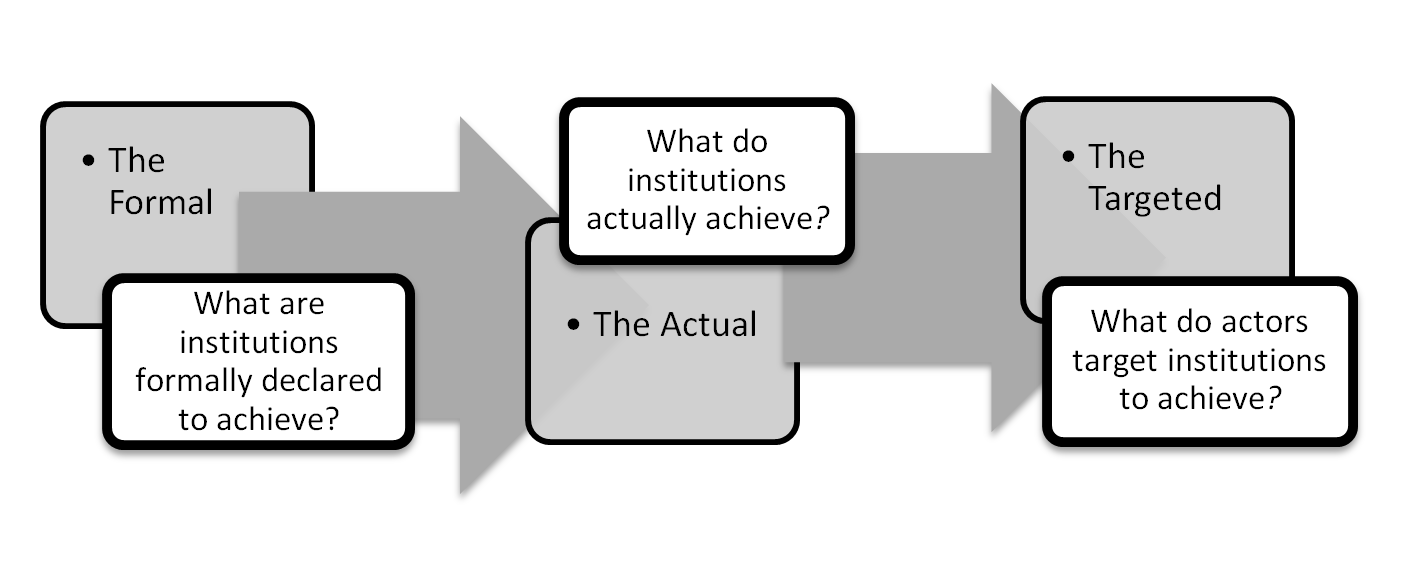“The larger the cognitive differences…
the more difficult to implement the policy”
engendering “uncertain policy outcomes” (Fan et al., 2021: 6)
During fieldwork, credibility cannot be assessed by simply asking a key informant, interviewee or respondent: Do you believe this policy or institution is credible? The manner through which credibility endogenously emerges from the incessant, complex interaction between multiple actors prevents this. For this reason, the Formal, Actual and Targeted Framework (FAT Framework) was developed to achieve a more reliable and temporally-sensitive understanding of credibility.
The development of the FAT Framework spanned a period of many years, and was inspired by Van Gelder (2010), who argued that a “tripartite view” on institutions (along three dimensions) is helpful in understanding the way in which they function. In effect, the framework establishes the differences between actors’ perceptions of what institutions are formally declared to achieve (the Formal), what they actually achieve (the Actual), and what actors’ target they should achieve (the Targeted) (see figure).
Formal, Actual and Targeted (FAT) Framework
Aim: The FAT Framework is a tool that endeavors to measure credibility along different dimensions and if needed, at different time-points. In this way, it can account for the multi-dimensionality and temporality that characterizes institutional credibility.
Assumption: The framework is predicated on the idea that perceptual divergence is a measure of credibility. Put differently, the greater the perceptual divergences, the lower the credibility. Notably, the reverse also holds: the smaller the perceptual divergences, the higher the credibility (see e.g. Arvanitidis and Papagianitsis, 2020).
Approach: The framework can be used for qualitative and quantitative analysis, and if needed, allows for a dynamic analysis of institutions through the inclusion of time and place. In this way, one can establish credibility before, during and after a certain intervention or policy. This is achieved by analyzing institutions at various time points, t1, t2….tx. Simultaneously, the FAT Framework can be conducted over space at different places, p1, p2…px.
Application: The FAT Framework has been tested for different sectors, e.g. land finance & value capture (Perez-Moreno, 2024), informal settlements (Sun and Ho, 2020), common property (Arvanitidis and Papagiannitsis, 2020), nature reserve management (Wang and Liu, 2022), environmental policy (Fan et al., 2021) and mega-projects such as dams, ports and high-speed railways (Nor-Hisham and Ho, 2016).
Temporally-sensitive FAT studies are, for instance, Nor-Hisham and Ho (2016) and Wang and Liu (2022), who executed this over two (before/after) or three time-points. Spatially-sensitive analyses have been used by Perez-Moreno (2024) for 3 levels (micro, meso, macro), and Wang and Liu (2022) for 5 levels (central to township).
Notably, Perez-Moreno (2024), Arvanitidis and Papagiannitsis (2020), and Fan et al. (2020) achieved significant innovations in refining the framework by respectively coupling it to the Conflict Analysis Model, Ostrom’s SES Framework, and credibility scores and weights.
